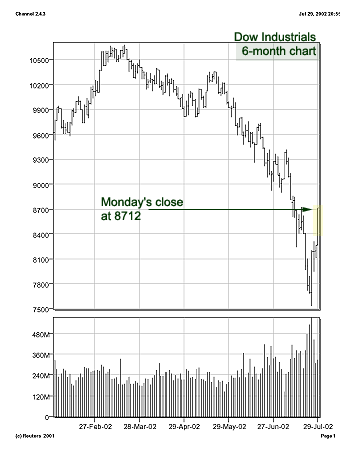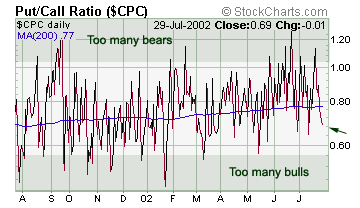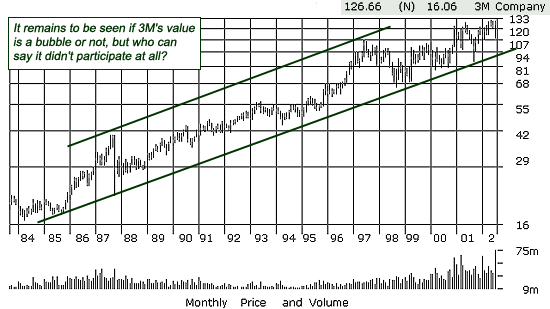|
So what if the Dow goes up by 15%
over the next three to four months. That's no consolation to anyone
that watched it drop 30% in the past four months. To recover losses
like that the average would have to rise 40% off its recent bottom,
near 7600. Besides, a fifteen percent move off that bottom means
an 8740 target, which is only 40 points away. In less than a week
the bulls erased one third of their prior 4 months worth of losses;
it is a feral display of volatility. The gains were broad during
Monday's dash of usual end of the month momentum, or at least 'usual'
during the bull market. The Dow average gained 447 points.
 All
the major US stock market averages gained more than five percent
save the Dow Utility Average, which gained only 1.4% on Monday.
Advancers led decliners 9:2, and nearly 2 billion shares changed
hands on the big board. All
the major US stock market averages gained more than five percent
save the Dow Utility Average, which gained only 1.4% on Monday.
Advancers led decliners 9:2, and nearly 2 billion shares changed
hands on the big board.
It was a solid bullish romp. Technically,
the move was significant provided it was not related to month end
nonsense, but even so, the significance was minor.
What I mean is that bears still have
control over the short term down trend, defined by 925 on the S&P
500, 1420 for the Nasdaq composite, 490 in the NYSE composite, and
8700 for the Dow Jones Industrials, which closed just above resistance
at 8712 Monday. The rest of the major US market averages closed
below nearby resistance, despite the bullish four-day affair so
far.
Still, the surprising nature of the
momentum should be disturbing to the bears. If so they may find
solace in the sentiment data. The S&P 500 Call-Put ratio reveals
just about the same amount of bullish sentiment today as it did
at May's bullish levels - at the tail end of a small two week rising
wedge in the average that represented the bullish rebuttal to an
early May break down from a (intermediate) double top.
The CBOE put-call ratio registers
a less bullish reading than it did in May, but infers as much bullish
sentiment as at any time since May. A reading in this statistic
below 0.60 has proven to be a reliable sell signal so far this year.
 The
current reading below the 200 day moving average (blue line in the
chart) only means to us that the indicator is closer to giving us
a sell signal than a buy signal, and this while the bulls have hardly
put a dent in the bearish technical arguments. The
current reading below the 200 day moving average (blue line in the
chart) only means to us that the indicator is closer to giving us
a sell signal than a buy signal, and this while the bulls have hardly
put a dent in the bearish technical arguments.
Keep 'em bullish boys. One or two
more days of this could do it. Or we could get a turn around for
the bulls that results in a bear market rally, sort of like the
summer rally everyone's been expecting, only from far lower levels.
Or we could get a brand new bull market.
But I don't think this is much more
than a bullish rebuttal while the market makes its invariable transition
from the Tech sector to the mighty Dow for its bearish leadership.
We've argued for almost a year that
the Dow is likely to take over the bear market's leadership job
as we enter into the next phase of the bear market, where the broad
market's losses tend to accelerate. What better time for this transition
than when these averages fall through their 9-11 lows to new four
and five year lows, signaling an extension to the two year primary
bear market?
The bulls of course still largely
insist the transition will never happen, and also that the worst
of the bear market be behind us.
From a technical standpoint I think
it's almost necessary to see the Dow capitulate, meaning relative
to the broad market, before we can legitimately call for the end
of a bear market. I labor under the impression that the Dow Industrials
fall last in a bear market (primary), but normally lead us out of
it also.
Stocks such as IBM for instance were
able to resist the technology bear until April of this year. It
just broke down, as did the rest of the market soon afterward -
in July (this month) all the averages sent us another primary bear
market signal, but only the Dow had recovered it since.
When something breaks out or breaks
down, usually we look for confirmation, which often means an assessment
of the rebuttal. The current stock market rally is thus a rebuttal
to July's primary sell signal, in our view. The challenge facing
the bulls is for them to take back all of July's losses in order
to show us that they weren't real. But it's going to be tough to
sell us on the idea that the bear market is over, particularly to
the extent the argument is premised on the idea the Dow never participated
in the bubble in the first place.
Fallacious Bubbleheads
With religious fervor, Wall Street media henchmen (and women) have
been applying Mr. Greenspan's bubble model to the markets. The model
was first developed after his "irrational exuberance" speech in
1996 in which he forecast a major market top boosted him into top
spot for the lame duck economic forecaster of the year award yet
again (perhaps the award is a prerequisite for the transition to
a dove). In 1996 you see, the Dow was hovering around 5500. His
speech resulted in one last dip to near 5300 then the market was
never going to see those levels again, to this day.
From that day forward, a bubble definition
was only to be applied in hindsight, for if the Mighty Quinn couldn't
tell the difference ahead of time, no one could. From that day forward,
millions of individual investors making investment decisions throughout
the land could not be wrong collectively. In other words, markets
were always going to be right, just like it says in the textbooks.
The markets have become so efficient
that it is irrelevant whether any or all of these individual investors
understand the way that inflation works itself through the system
because collectively they do understand. It doesn't matter that
inflation affects the individual's valuation judgment, or that it
breeds irrational exuberance and manifests as malinvestment and
debased currency. None of that matters because the markets work
just like they say in the textbooks, efficiently. They're never
wrong.
So why are they so volatile if
they're so efficient? To which the devout bull would probably
answer they weren't volatile until the recent crisis of confidence,
commonly attributed to the corporate crime wave, as if it didn't
exist on the way up.
The aggressive accounting tactics,
I'll say it again hoping someone will hear, were clearly visible
during the bull market. But the collective brilliance of the market
failed to see them for what they were: a consequence of the bubble,
which resulted from the inflation that the Fed is supposed to monitor.
So of course, if the Greenspan Fed can't see a bubble forming right
under its collective feet while their "pedal is to the metal" at
the local printing presses how on earth could anyone else see one?
Or so goes the parable.
In true form, one analyst after another
says it. At first, it's absurdity gets a shake of the head, the
next time it is heard, it gets a twitch of the lip, the third time
it's heard it gets a turn of the head combined with the wonder of
how these people can say it over and over again. It must be that
nobody has questioned it. So we will.
The nineties stock market bubble
was not simply isolated to the technology sector!!

It's just that you'll never get 150
P/E ratios out of the blue chips until they're profits disappear
altogether. Even the 1929 stock market bubble resulted in only a
P/E ratio just above 20. It wasn't until after the crash that the
ratio spiked up to over 200 on several occasions in the early thirties.
During the late fifties, according to data from the chart above
(just ahead of the go-go era for tech stocks) the Dow Industrials
got up to about a 25 times trailing earnings multiple. I'm sure
it was cheap with respect to earnings outlooks. Excluding the spikes
in this ratio usually attributable to profits depressions, the only
other time the Dow Industrials were priced as high during their
boom phase was just before the 1987 crash, during the late nineties,
and now.
There are two ways to argue against
us. The first is that many Dow stocks are also technology stocks
and they heavily influence the multiple on the Dow average. The
second is that the P/E ratio is a far too rudimentary measure of
value to be useful in today's world of high finance.
Indeed there are seven Dow components
we would call pure technology plays. They are Hewlett Packard, IBM,
Intel, Microsoft, SBC Communications, AT&T, and United Technologies.
These stocks were priced at between 30 and 60 times earnings during
the best part of the nineties boom in 1999.
But these aren't fly by night operations.
To imply that the impact on the rest of the economy, and other markets,
from the valuation distortions reminiscent in only these stocks
was neutral is a bullishly biased inference today.
Moreover, stocks like Du Pont went
for 50 times earnings in 1998. American Express went for 30 times
earnings in 1999; Disney went for better than 70 times earnings
in early 2000; GE went for 45 times earnings by mid 2000; Home Depot
went for 60 times earnings in early 2000; Johnson & Johnson traded
at almost 40 times earnings during early 1999; Coca Cola traded
at 50 times earnings from 1998 to 2000 then it traded up to almost
90 times earnings in 2000 when earnings began to fall; McDonald's
traded up to about 38 times earnings in early 1999; Merck traded
just higher than 35 times earnings in 1999; Wal-Mart traded for
50 times earnings in 1999. Should we continue?

Reuters-Bridge
The list is long, and the bubble
permeated the entire stock market, not just the tech sector. Mostly
the tech sector, but not "just." Even 3M, the epitome of old economy
stocks in the Dow, traded for 28 times earnings in 1999, and today
trades for almost 30 times earnings. Clearly then, it wasn't only
the technology sector that influenced the Dow's multiple during
the height of the boom, or even now.
To say that the bubble is isolated
to the technology sector is a fallacy. What's more, it's probably
damage control by our economic managers to promote that fallacy,
as if the inflation was still under control.
But even if it isn't that, it is
the rudimentary application of the Greenspan model for a bubble,
which the world's blue chip analysts are blindly applying to the
markets that have now come down the most. Since the tech sector
has given up most of its gains, that is where the bubble must have
been, right? The Dow has been dropping less quickly so therefore
it can't be a bubble yet. This application of hindsight bubble-o-nomics
is going to acknowledge a bubble only if and when the blue chips
fall much further.
Of course, there are better measures
of value than the simple P/E ratio. But they'll all show similar
results in hindsight. In our view, value is subjective anyway, so
it is not the actual number that matters, but which way it's likely
to go that does. Nonetheless, this is a big topic and one we'll
leave for subscribers in a future issue.
It is our view at the moment that
the price of gold & gold shares have discounted a material bounce
in the Dow as well the US dollar, both of which are underway. We
don't share the enthusiasm for Wall Street assets that the 4-day
bullish affair implies that others have at the moment.
Until Monday, the bond markets were
able to hold on to their gains. But Treasuries were knocked back
a few notches as confidence did in fact grow in a stock market recovery
on Monday.
Further losses in the bond are likely
to first signal a rise in this confidence, but then it is likely
that their rising yields will also lower the equity risk premium
yet again.
The persistent decoupling of these
two assets will continue until the bear market has run its course.
The sticky bond yield has been an efficient primary controlling
variable for equity values, and we expect it to continue so.
Well, who needs the Fed anyway?
Ed Bugos
|

